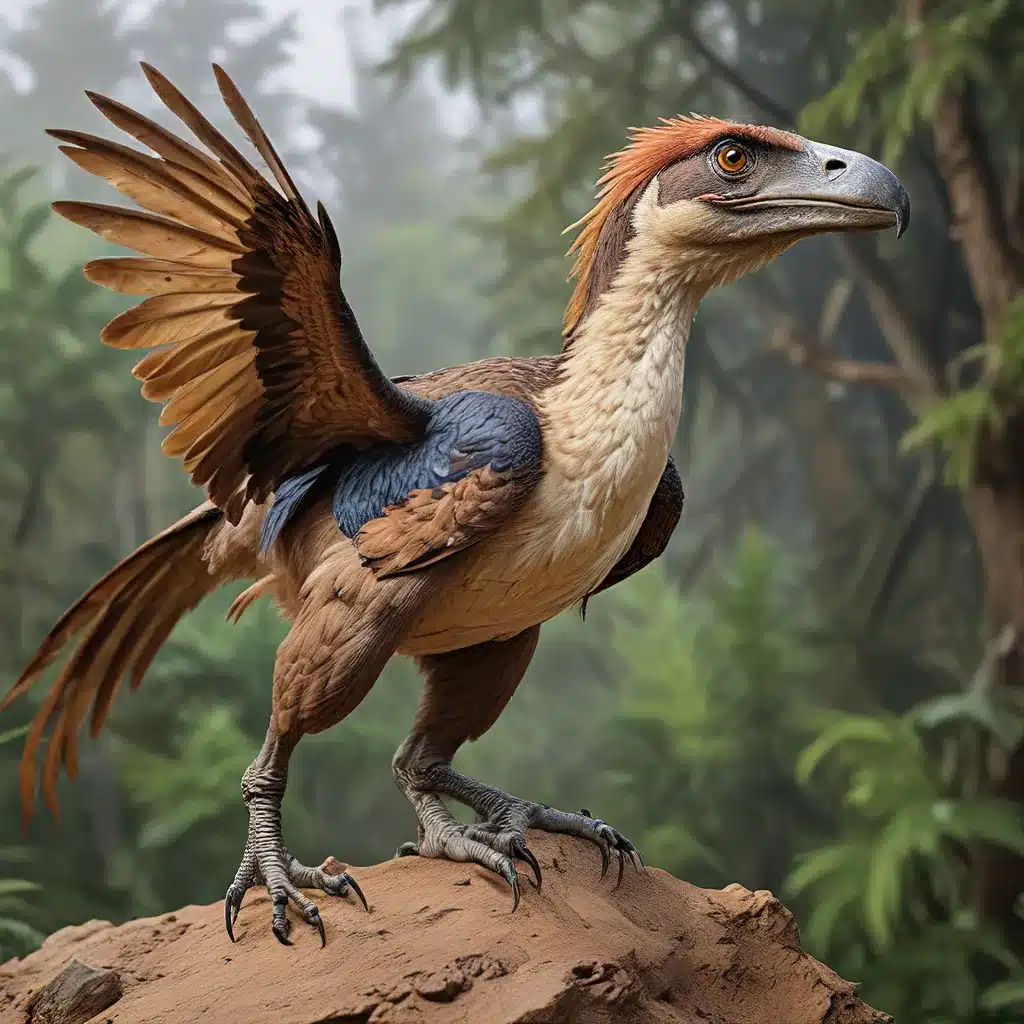
In the captivating world of paleontology, the quest to unravel the mysteries surrounding the evolution of dinosaurs has been a long-standing fascination. One of the most intriguing aspects of this endeavor is the ongoing debate over the origins of feathers and their connection to the theropod dinosaurs, the group that includes the iconic Tyrannosaurus rex and its kin.
Uncovering the Clues in the Fossil Record
The discovery of Psittacosaurus, a smaller dinosaur specimen from the Jehol Biota of China, has provided researchers with a unique opportunity to shed light on this evolutionary puzzle. This fossil, with its striking preservation of skin and possible feather-like structures, has become a focal point in the ongoing discussion about the evolution of feathers.
Fossil experts from University College Cork in Ireland have taken stunning images of the Psittacosaurus skin, revealing patches that glow orange under UV light. Even more intriguing is the presence of long fibers on the top of the dinosaur’s tail, which many assume were feather-like bristles. This discovery has led the study authors to suggest that, since this dinosaur had two types of skin, perhaps the evolutionary ancestors of today’s birds did as well.
However, a closer examination of the evidence reveals a more complex story. While the researchers were able to verify that some of the dinosaur’s skin did indeed have reptilian scales, complete with dark structures called melanosomes, they found no evidence of the proposed feather-making skin or associated follicles. In the absence of such crucial evidence, the study authors resorted to simply asserting that the skin in the feathered regions “exhibited some or all of the modifications related to feather support and movement that characterize the skin of extant birds.” This, according to some evolutionary biologists, is a questionable assumption.
The Ongoing Debate: Feathers or Fakes?
The debate surrounding the evolution of feathers from reptilian scales has been a contentious one, with researchers presenting conflicting interpretations of the available evidence. Some paleontologists, such as Alan Feduccia, an evolutionary bird paleontologist, have published studies challenging the idea that dinosaurs had feathers or proto-feathers.
Feduccia’s research has shown that so-called “dino-fuzz” is more likely the fossil remains of thin collagen fibers left over from partially decomposed skin, rather than true feather-like structures. He has also argued that the claimed “feathered dinosaurs” are actually just bony-tailed birds with genuine feathers, like the famous Archaeopteryx, one of the earliest known birds.
The problem with the dinosaur-to-bird evolution theory, as Feduccia and others have pointed out, is that the “descendant” birds appear in the fossil record before their supposed “ancestral” dinosaurs. This presents a significant challenge to the mainstream evolutionary narrative, as it suggests that the evolutionary timeline has been misinterpreted or that essential “ghost lineages” remain undiscovered.
Challenging the Evolutionary Assumptions
The ongoing debate surrounding the evolution of feathers highlights the importance of critically examining the underlying assumptions and interpretations of the fossil record. As the source information suggests, the presence of soft tissues, proteins, and intact biomolecules in dinosaur fossils, which should not exist in specimens millions of years old, calls into question the widely accepted timelines and evolutionary narratives.
Additionally, the anatomical features of dinosaurs, such as their narrow nasal passages and lack of specialized respiratory structures found in warm-blooded animals, indicate that they were likely cold-blooded, similar to modern reptiles. This challenges the notion that dinosaurs were warm-blooded creatures capable of thriving in cold, snowy environments, as depicted in popular media like the Jurassic Park franchise.
Furthermore, the size and structure of dinosaur brains, which are more akin to those of living reptiles like alligators and crocodiles, cast doubt on the idea that these ancient creatures possessed the level of intelligence and cognitive abilities often attributed to them, particularly in relation to their supposed evolutionary transition to birds.
A Closer Look at the Fossil Evidence
The ongoing debate over the evolution of feathers and the relationship between dinosaurs and birds highlights the importance of carefully examining the fossil evidence and not relying solely on evolutionary assumptions. As the source information indicates, the presence of intact soft tissues and biomolecules in dinosaur fossils, as well as the lack of evidence for the proposed feather-making skin and follicles in the Psittacosaurus specimen, challenge the mainstream narrative.
Ultimately, the evolution of feathers from reptilian scales remains a poorly understood event, with the available evidence presenting more questions than answers. This serves as a reminder that the pursuit of scientific knowledge requires an open-minded and critical approach, one that is willing to challenge long-held assumptions and explore alternative explanations.
As researchers continue to uncover new fossil discoveries and refine their understanding of ancient life, the story of the feathered theropods and their evolutionary origins is sure to remain a captivating and controversial topic in the field of paleontology. By approaching these questions with a willingness to consider diverse perspectives and weigh the evidence objectively, we may one day unlock the true evolutionary enigmas of these fascinating creatures.


